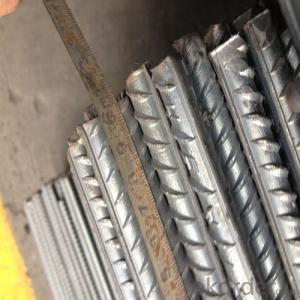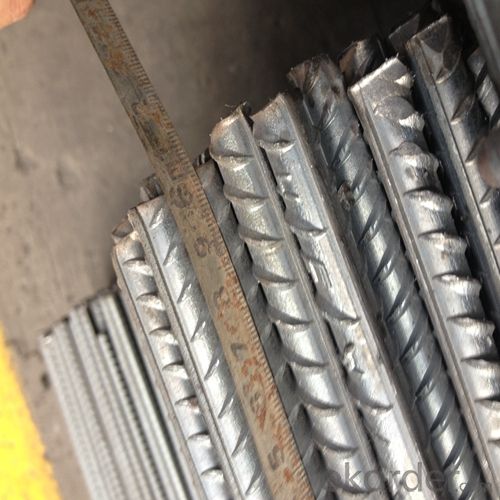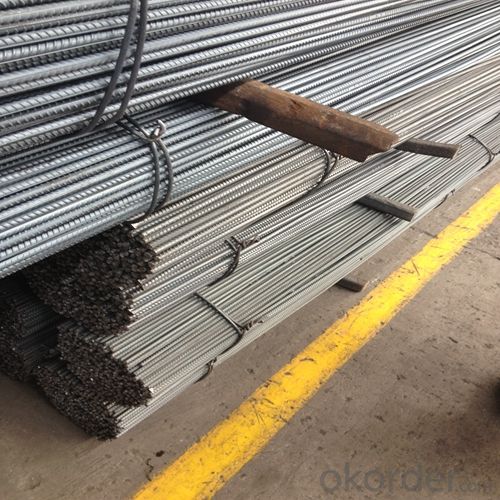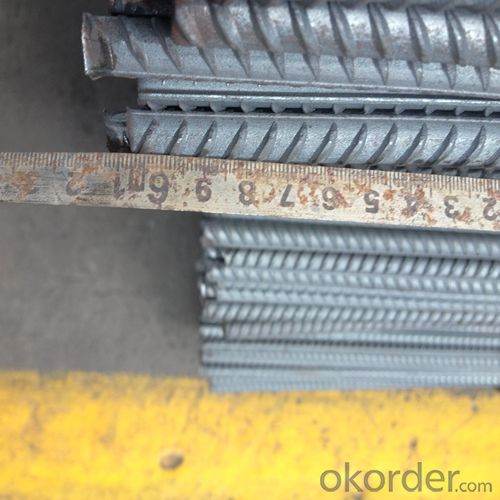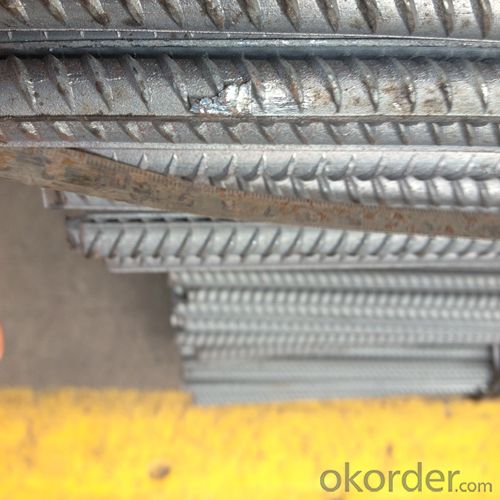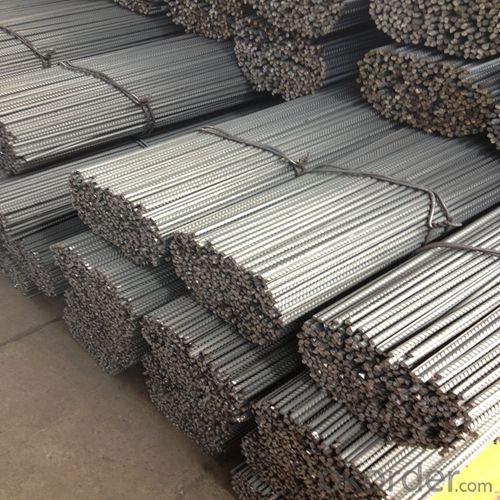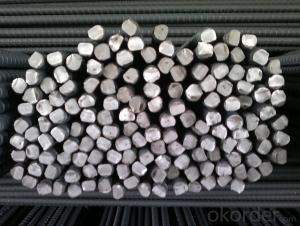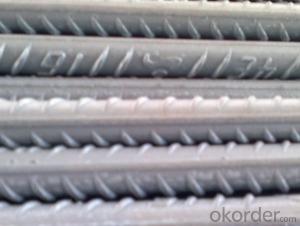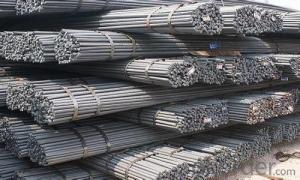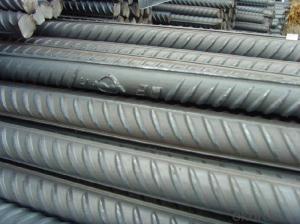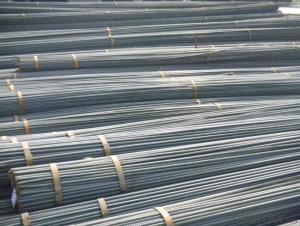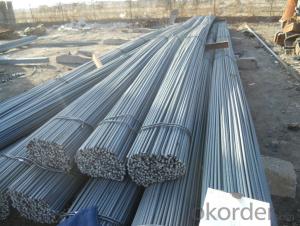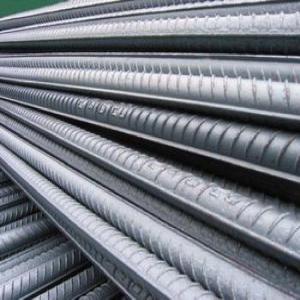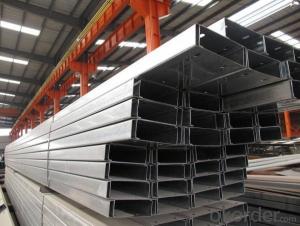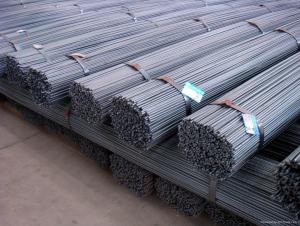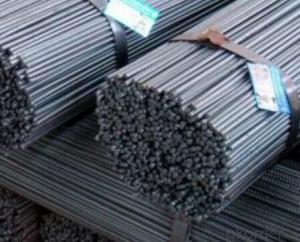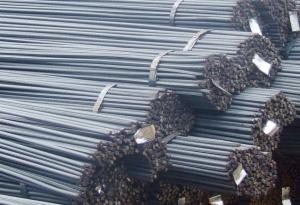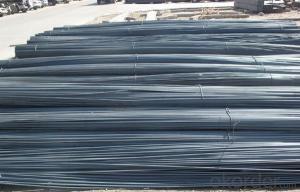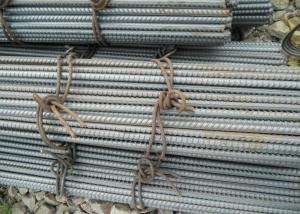Hot Rolled Steel Rebar Deformed Bar Made In China
- Loading Port:
- Tianjin
- Payment Terms:
- TT OR LC
- Min Order Qty:
- 2000 m.t.
- Supply Capability:
- 30000 m.t./month
OKorder Service Pledge
OKorder Financial Service
You Might Also Like
Product Description:
Specifications of Deformed Steel Bar:
Standard | GB | HRB335, HRB400, HRB500 | |
UK | G460B, B500A, B500B,B500C | ||
USA | GR40, GR60 | ||
Diameter | 6mm,8mm,10mm,12mm,14mm,16mm,18mm,20mm, 22mm,25mm,28mm,32mm,36mm,40mm,50mm | ||
Length | 6M, 9M,12M or as required | ||
Place of origin | Hebei, China mainland | ||
Application | building,construction,road,bridge etc | ||
Brand name | DRAGON | ||
Theoretical weight and section area of each diameter as below for your information:
Diameter(mm) | Section area (mm²) | Mass(kg/m) |
6 | 28.27 | 0.222 |
8 | 50.27 | 0.395 |
10 | 78.54 | 0.617 |
12 | 113.1 | 0.888 |
14 | 153.9 | 1.21 |
16 | 201.1 | 1.58 |
18 | 254.5 | 2.00 |
20 | 314.2 | 2.47 |
22 | 380.1 | 2.98 |
25 | 490.9 | 3.85 |
28 | 615.8 | 4.83 |
32 | 804.2 | 6.31 |
36 | 1018 | 7.99 |
40 | 1257 | 9.87 |
50 | 1964 | 15.42 |
Chemical Composition: (Please kindly find our chemistry of our material based on HRB500 as below for your information)
Grade | Technical data of the original chemical composition (%) | ||||||
C | Mn | Si | S | P | V | ||
HRB400 | ≤0.25 | ≤1.60 | ≤0.80 | ≤0.045 | ≤0.045 | 0.04-0.12 | |
Physical capability | |||||||
Yield Strength (N/cm²) | Tensile Strength (N/cm²) | Elongation (%) | |||||
≥400 | ≥570 | ≥14 | |||||
Usage and Applications of HRB400 Deformed Steel Bar:
Deformed bar is widely used in buildings, bridges, roads and other engineering construction. Big to highways, railways, bridges, culverts, tunnels, public facilities such as flood control, dam, small to housing construction, beam, column, wall and the foundation of the plate, deformed bar is an integral structure material. With the development of world economy and the vigorous development of infrastructure construction, real estate, the demand for deformed bar will be larger and larger..
Packaging & Delivery of HRB400 Deformed Steel Bar:
Packaging Detail: products are packed in bundle and then shipped by container or bulk vessel, deformed bar is usually naked strapping delivery, when storing, please pay attention to moisture proof. The performance of rust will produce adverse effect.
Each bundle weight: 2-3MT, or as required
Payment term: TT or L/C
Delivery Detail: within 45 days after received advanced payment or LC.
Label: to be specified by customer, generally, each bundle has 1-2 labels
Trade terms: FOB, CFR, CIF
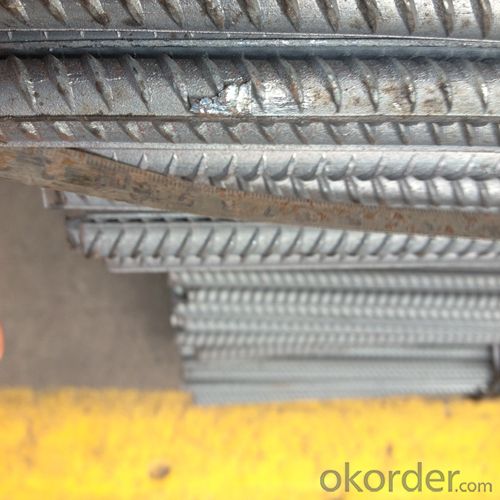
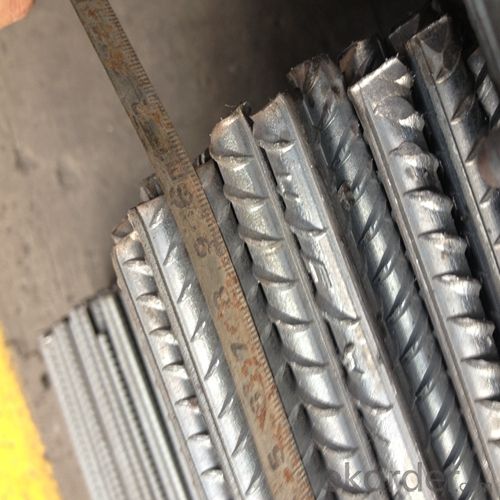
- Q: 12 how much is one ton of thread steel?
- If it is hrb400e three grade rebar, then 12 of the meter price is 2.07 yuan; if it is hrb50 four grade rebar, that 12 of a meter price of 2.23 yuan.
- Q: What is the recommended diameter of steel rebars for slab reinforcement?
- The recommended diameter of steel rebars for slab reinforcement typically ranges from 8mm to 32mm, depending on the specific requirements of the slab design and the expected load-bearing capacity.
- Q: How do steel rebars affect the overall thermal stability of a structure?
- Steel rebars can significantly improve the overall thermal stability of a structure. Due to their high thermal conductivity, steel rebars help in dissipating heat more efficiently and evenly throughout the structure. This prevents the formation of localized hot spots and reduces the risk of thermal expansion, which can cause structural deformations and cracks. Additionally, steel rebars enhance the structural integrity of a building during fire incidents by providing necessary reinforcement and preventing sudden collapses.
- Q: How do steel rebars impact the overall constructability and scheduling of concrete projects?
- The constructability and scheduling of concrete projects are greatly influenced by the presence of steel rebars. These reinforcing bars are essential for providing strength and stability to concrete structures, ensuring their durability and resilience. To begin with, the inclusion of steel rebars within the concrete significantly improves the overall structural integrity of the project, enhancing its constructability. By reinforcing and supporting the concrete, the rebars enable the construction of taller and more complex structures. They help distribute the load and withstand tension and compression forces, making the project more reliable. Furthermore, the presence of steel rebars facilitates the scheduling of concrete projects. When properly planned and incorporated, the rebars can expedite construction timelines. By integrating the rebars into the concrete formwork, construction teams can efficiently pour and shape the concrete, reducing the curing time required to achieve the desired strength. This directly affects project scheduling, enabling faster construction progress and potential cost savings. In addition, the utilization of steel rebars in concrete projects allows for flexibility in design and construction. The ability to customize the placement, size, and spacing of rebars ensures that the concrete structure meets specific design requirements and intended functionality. This flexibility becomes particularly crucial in projects that involve intricate architectural features or require specific load-bearing capacities. However, it is important to acknowledge that the proper installation and coordination of steel rebars can present challenges in terms of scheduling. To avoid delays, rebar installation must be carefully coordinated with other construction activities. Moreover, quality control measures are essential to ensure the accurate placement and alignment of rebars, as any errors or deficiencies can significantly impact the overall quality and safety of the project. In conclusion, steel rebars have a significant impact on the constructability and scheduling of concrete projects. They enhance the strength and stability of concrete structures, allowing for the construction of more intricate and robust designs. Additionally, the proper incorporation of rebars can expedite construction timelines and provide flexibility in project scheduling. However, careful planning, coordination, and quality control are necessary to ensure the successful integration of rebars in concrete projects.
- Q: Can steel rebars be used in industrial buildings?
- Yes, steel rebars are commonly used in industrial buildings as they provide excellent reinforcement for concrete structures, enhancing their strength and durability.
- Q: How is thread steel made?
- The billets used in continuous small mills are generally continuous billets, the length of which is usually 130~160mm, the length is about 6~12 meters, and the billets are 1.5~3 tons in weight. The rolling line is mostly flat interchange arrangement to realize all round rolling without torsion. According to different billet specifications and finished sizes, there are 18, 20, 22 and 24 small mills, 18 of which are mainstream. The use of bar rolling reheating furnace, high pressure water descaling, in addition to the new technology of low-temperature rolling, endless rolling, rolling, rolling development to adapt and improve the precision of rolling billet, rolling mill is mainly to improve the accuracy and speed (up to 18m/s). Product specifications are generally phi 10-40mm, Phi Phi 6-32mm or 12-50mm. The steel grades produced are low, medium and high carbon steels and low-alloy steels, which are widely needed in the market. The maximum rolling speed is 18m/s. The production process is as follows:Reheating furnace, roughing mill, rolling mill, rolling mill, water cooling device, cooling bed, cold shear, automatic counting device, bundling machine, unloading bench is calculated from the Shanghai kuanli Steel Co. Ltd. to provide thread steel weight: diameter * * outer diameter theory 0.00617=kg/m theory and 6.50.260 steel manufacturers specifications Jiuzheng 8.00.395 Jiuzheng steel 100.617 steel 120.888 steel 141.21 nine nine nine nine nine steel 161.58 steel 182 steel 202.47 steel 222.98 steel 253.85 nine nine nine nine nine steel 284.83 steel 326.31 steel.
- Q: How do steel rebars contribute to the overall fire safety of a structure?
- Steel rebars contribute to the overall fire safety of a structure by providing reinforcement and strength to concrete, making it more resistant to heat and fire. The high melting point of steel ensures that the rebars maintain their structural integrity even under extreme temperatures, preventing the collapse of the building.
- Q: What are the different types of steel rebars used in retaining walls?
- There are several types of steel rebars commonly used in retaining walls, including plain round bars, deformed bars, epoxy-coated bars, and galvanized bars. Plain round bars are smooth and typically used in low-load applications. Deformed bars have ribs or indentations that provide better adhesion with the concrete, making them suitable for high-load situations. Epoxy-coated bars have a protective coating that prevents corrosion and are often used in marine or corrosive environments. Galvanized bars are coated with a layer of zinc to enhance their resistance to rust and are commonly employed in areas with high moisture content. The choice of rebar type depends on the specific requirements of the retaining wall project.
- Q: How do steel rebars contribute to the structural integrity of a building?
- Steel rebars, also known as reinforcing bars, play a crucial role in enhancing the structural integrity of a building. These bars are embedded within concrete structures, such as beams, columns, and slabs, to provide tensile strength and prevent cracking or failure under load. By reinforcing the concrete, steel rebars help distribute and resist the forces acting on the structure, ensuring its stability and durability.
- Q: How do steel rebars help in reducing construction time?
- Steel rebars help in reducing construction time by providing structural reinforcement to concrete elements such as beams, columns, and slabs. These rebars enhance the strength and durability of the concrete, allowing for quicker construction processes. The use of steel rebars eliminates the need for excessive formwork, as the reinforced concrete can be poured into pre-designed molds, saving time and effort. Additionally, steel rebars enable faster curing of concrete, allowing construction projects to progress swiftly.
Send your message to us
Hot Rolled Steel Rebar Deformed Bar Made In China
- Loading Port:
- Tianjin
- Payment Terms:
- TT OR LC
- Min Order Qty:
- 2000 m.t.
- Supply Capability:
- 30000 m.t./month
OKorder Service Pledge
OKorder Financial Service
Similar products
Hot products
Hot Searches
Related keywords
